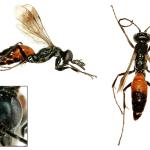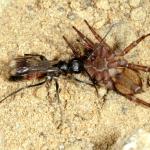Priocnemis fennica belongs in Priocnemis sens. str., where, along with hyalinata (Fabricius), it exhibits the character of a greatly enlarged inner tooth on the tarsal claw. Males exhibit distinct differences in their genitalia in comparison to hyalinata; females of both species are more similar and the characters to separate them more subtle (Day, 1988).
It has only relatively recently been recognised as British (Day, 1979) and older records of ‘hyalinata’, or its synonym femoralis, might refer to either species; fennica actually being more widespread in Britain.
England, common in the south but apparently absent from the south-west and local in Wales. Also recorded from Ireland (O’Connor et al., 2009). Not recorded from either Scotland or the Channel Islands
It occurs in northern and central Europe (Wolf, 1972). France, Belgium, Netherlands, Luxembourg, Italy, Germany, Denmark, Austria, Czech Republic, Slovakia, Poland, Belarus and Finland (Wahis, 2011).
This species is not regarded as being scarce or threatened.
Occurs in a range of habitats, although usually there is an association with trees. An affinity for watersides has also been suggested (Day, 1988).
Late May to early September.
Little definitive data because of the confusion with hyalinata. A record of Pardosa pullata (Clerck) (Lycosidae) from Ireland was considered to be prey of fennica (Day, 1988). There are various published records of species of Lycosidae and Salticidae as prey but these could apply to either P. fennica or P. hyalinata.
No data available. Priocnemis species in general are fossorial nesters, often adapting preexisting cavities or old aculeate burrows.
No data available. Priocnemis species in general are often found at flowers of umbellifers such as wild carrot and wild parsnip.
No data available.
2012



